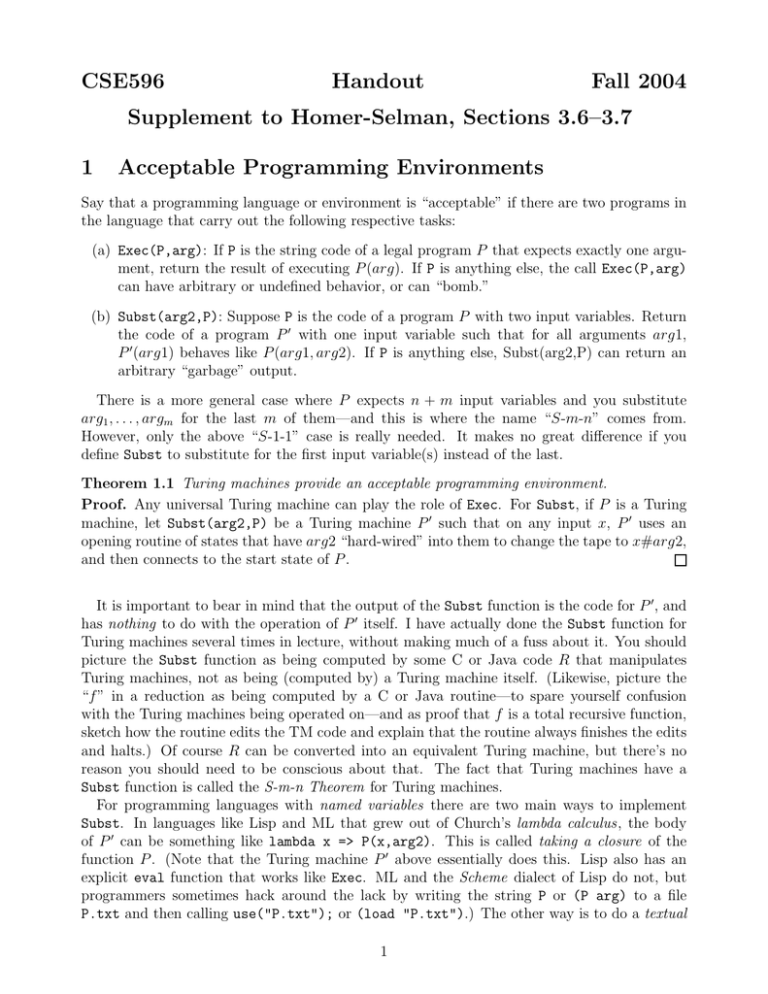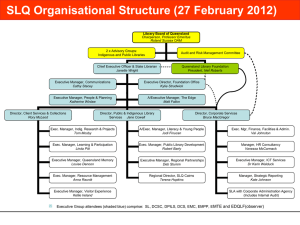CSE596 Handout Fall 2004 Supplement to Homer-Selman, Sections 3.6–3.7
advertisement

CSE596
Handout
Fall 2004
Supplement to Homer-Selman, Sections 3.6–3.7
1
Acceptable Programming Environments
Say that a programming language or environment is “acceptable” if there are two programs in
the language that carry out the following respective tasks:
(a) Exec(P,arg): If P is the string code of a legal program P that expects exactly one argument, return the result of executing P (arg). If P is anything else, the call Exec(P,arg)
can have arbitrary or undefined behavior, or can “bomb.”
(b) Subst(arg2,P): Suppose P is the code of a program P with two input variables. Return
the code of a program P 0 with one input variable such that for all arguments arg1,
P 0 (arg1) behaves like P (arg1, arg2). If P is anything else, Subst(arg2,P) can return an
arbitrary “garbage” output.
There is a more general case where P expects n + m input variables and you substitute
arg1 , . . . , argm for the last m of them—and this is where the name “S-m-n” comes from.
However, only the above “S-1-1” case is really needed. It makes no great difference if you
define Subst to substitute for the first input variable(s) instead of the last.
Theorem 1.1 Turing machines provide an acceptable programming environment.
Proof. Any universal Turing machine can play the role of Exec. For Subst, if P is a Turing
machine, let Subst(arg2,P) be a Turing machine P 0 such that on any input x, P 0 uses an
opening routine of states that have arg2 “hard-wired” into them to change the tape to x#arg2,
and then connects to the start state of P .
It is important to bear in mind that the output of the Subst function is the code for P 0 , and
has nothing to do with the operation of P 0 itself. I have actually done the Subst function for
Turing machines several times in lecture, without making much of a fuss about it. You should
picture the Subst function as being computed by some C or Java code R that manipulates
Turing machines, not as being (computed by) a Turing machine itself. (Likewise, picture the
“f ” in a reduction as being computed by a C or Java routine—to spare yourself confusion
with the Turing machines being operated on—and as proof that f is a total recursive function,
sketch how the routine edits the TM code and explain that the routine always finishes the edits
and halts.) Of course R can be converted into an equivalent Turing machine, but there’s no
reason you should need to be conscious about that. The fact that Turing machines have a
Subst function is called the S-m-n Theorem for Turing machines.
For programming languages with named variables there are two main ways to implement
Subst. In languages like Lisp and ML that grew out of Church’s lambda calculus, the body
of P 0 can be something like lambda x => P(x,arg2). This is called taking a closure of the
function P . (Note that the Turing machine P 0 above essentially does this. Lisp also has an
explicit eval function that works like Exec. ML and the Scheme dialect of Lisp do not, but
programmers sometimes hack around the lack by writing the string P or (P arg) to a file
P.txt and then calling use("P.txt"); or (load "P.txt").) The other way is to do a textual
1
substitution on the named input variable that will hold the second argument. Then one changes
the Subst function to
(b0 ) Subst(arg,"z",P): If z is the second of two input parameters of P, and if z is not on the
left side of an assignment in the body of P, return the code of the program P 0 obtained by
removing z as an input parameter and substituting arg for every occurrence of z in the
body of P. If P does not meet these conditions, Subst(arg,"z",P) can return garbage.
Here we may picture Subst as having three String arguments and returning the code of P 0 as
a String. It is taken for granted that z is a token that can be parsed in P. This was the general
form of the original Gödel substitution function, except that for Gödel, P was a formula of logic
rather than a program. The restriction on z is explained by saying that z is a read-only input
variable, like a const parameter in C++ or an in parameter in Ada, or any non-ref variable
in ML. (In C/C++ lingo one says that z is used only as an rvalue.)
In my research I use a dialect of C called Singular that provides an explicit Exec function
and some Perl-like functions for doing this kind of variable substitutions. Most implementations
of C itself allow one to do these things via low-level system calls. For what follows, however,
I will imagine a langauge that uses the basic C++ iostream library for input and output.
The C++ statement cin >> x >> z; reads two strings from standard input and assigns them
to the variables x and y. The statement cout << x << 5; outputs the value of x and then
the literal number 5. I will assume that the only cin statement comes at the beginning of a
program. Then Subst(arg,"z",P) is easy to implement by changing the “ >> z;” at the end
of the first statement to ; and substituting arg for every other occurrence of z. I will also
assume that my “mini-C++” also comes with a ready-made Exec command.
2
The Recursion Theorem
This theorem holds in any acceptable programming environment—via the proof in the text—
but for sake of intuition, I will prove and illustrate it for my “mini-C++” system.
Theorem 2.1 For any program P that you write with an uninitialized read-only variable
mycode, there is an efficient and straightforward way to massage P into a program P 0 that
works exactly the way you intended P to work, in which mycode is initialized to the string
encoding of P 0 .
Note that mycode is assigned not the code P of your P —which would be no great shakes—but
the code of the P 0 you obtain. If the last line of P is cout << mycode;, then P 0 will print its
own code. Technically your original P may not be a legal program if the compiler catches your
not having initialized the variable mycode, but the first step in the proof takes care of that.
Proof. First, alter your program P by appending >> mycode; in place of the ; in your
opening cin statement, and let P represent the String encoding of this program. Let us use
names for the following literal Strings:
ker = "cin >> y >> u; return Exec(Exec(u,u), y);"
eff = "cin >> e; return Subst(e,"mycode",P);"
arg = "cin >> w; return Exec(eff,Subst(w,"u",ker));"
Ppr = "Subst(arg,"u",ker);"
Here I intend that the literal text of your P is substituted directly into the string eff, and that
ker and eff are literally inserted into arg, and finally that ker and arg are inserted to give
2
you a final (pretty long) literal string Ppr. The internal quotes around u and mycode can be
escaped via \" or "" as appropriate. In relation to the Homer-Selman text:
• ker is the θ function on page 56, and works a little like a “micro-kernel.”
• eff is the code of the total recursive function f in Theorem 3.10 on page 56;
• Subst(w,"u",ker) returns the value of the function g in the proof of Theorem 3.10 on
page 56;
• arg is the code of the composition f ◦ g and equals k in the text; and
• Ppr will evaluate to g(k) on p56, which the text calls n on page 56 and e0 on page 57.
I claim that Ppr is the text of the desired program P 0 . For a classic (but general enough)
“proof by example,” let us suppose that your original program was
cin >> x;
cout << mycode;
return Rest_of_P(x);
Then P = "cin >> x >> mycode; cout << mycode; return Rest of P(x);" after the modification. To prove that the string Ppr gives the code of a P 0 that works equivalently to your
original P with mycode assigned the code of P 0 (i.e., Ppr itself is assigned to mycode), let us
trace the execution of P 0 on some argument a. We can use Exec(Ppr,a) itself to do this trace:
Exec(Ppr,a) = Exec(Subst(arg,"u",ker), a)
= Exec("cin >> y; return Exec(Exec(arg,arg), y);", a)
In the crucial next step, executing the string on the argument a results in a being substituted
for y. Note that Exec behaves much like Subst here. This leaves:
= Exec(Exec(arg,arg), a)
= Exec(Exec("cin >> w; return Exec(eff, Subst(w,"u",ker));", arg), a)
= Exec(Exec(eff, Subst(arg,"u",ker)), a)
= Exec(Exec("cin >> e; return Subst(e,"mycode",P);", Subst(arg,"u",ker)), a)
= Exec(Subst( Subst(arg,"u",ker), "mycode", P), a)
= Exec(Subst( Ppr, "mycode", P), a).
The last line tells you in full generality that what you get by running Ppr on input a is the
same as what you get by running your original P on input a but with Ppr itself substituted for
mycode, which is exactly what you wanted! In this case, you get
= Exec(Subst( Ppr, "mycode", "cin >> x >> mycode; cout << mycode;
return Rest_of_P(x);"), a)
= Exec("cin >> x; cout << Ppr; return Rest_of_P(x);", a).
This prints Ppr and then calls Rest_of_P(a), whose body may contain further references to
mycode. That’s enough for the proof!
If you make Rest_of_P(a) accept a if and only if a == mycode, then you have a program
P 0 that accepts only its own code. In the text’s traditional notation, this gives you n such that
Wn = { n }. The “modified program P(x,mycode)” above is the same as the text’s “ψ(x, e0 )”
on page 57, with its two arguments interchanged.
3



